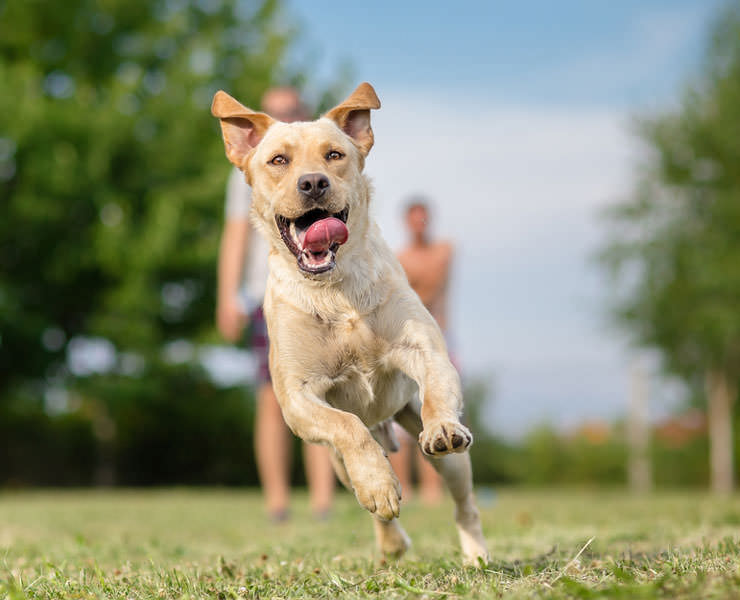Obesity is an issue that dogs and cats are struggling with more frequently and owners certainly face a challenge when dealing with a lazy cat or a treat-obsessed pooch!
This springtime take the opportunity to make some small changes at home so that your pets can enjoy a healthy and active summer to the utmost.
Is it more than just fluff?
The first step you can take at home is to roughly gauge how far along the “chubby” scale your pet is. A simple test you can use is the Body Condition Score (BCS) system, which uses a few key indicators to gauge pet body type:
- First, run you hands over your pet’s ribcage. An overweight pet will have more fat over their ribs, which will make them difficult or impossible to feel.
- Next, look at you pet from above. Can you see a defined waist behind their ribs, or are they more rounded?
- Lastly, look at you pet from the side. Their “abdominal tuck” is the area where their tummy should narrow up towards their hips, but an overweight cat or dog might have a distended “pooch” that hangs down.
The extra fat you can feel is evident on the scale as well. Try using this chart from Pet Obesity Prevention to find your pet’s breed-specific ideal weight range and see how they’re currently measuring up.
Next, talk to your vet!
 So, your pet appears to be on the heavy side; what should you do to address it? Consulting your veterinarian is an important step to take before starting any weight loss plan. External exams only tell us part of the story when it comes to pet health and only your vet can test for internal issues. Consider that obesity can result in increased rates of kidney disease, type 2 diabetes, osteoarthritis and even some cancers, so getting the full picture of their current health is crucial.
So, your pet appears to be on the heavy side; what should you do to address it? Consulting your veterinarian is an important step to take before starting any weight loss plan. External exams only tell us part of the story when it comes to pet health and only your vet can test for internal issues. Consider that obesity can result in increased rates of kidney disease, type 2 diabetes, osteoarthritis and even some cancers, so getting the full picture of their current health is crucial.
Your vet can also weigh in on an appropriate plan and food to help them slim down! Make an appointment today.
Weight management foods

Once you’ve got the OK to proceed, you should try looking into weight management food formulas. They should be specifically designed to meet the protein, fat and vitamin needs of cats and dogs, while replacing the extra calories of filler ingredients with high fibre instead. There are even formulas being designed to help satiate appetites for longer (hopefully reducing the begging behaviours of the worst scamps).
Remember that a good pet food is a complete and balanced formula, that requires no additional treats for nourishment. Stay strong, and reward with pets and attention instead!
On that note, implementing daily meal times and portion control is important. Follow the daily feeding amount indicated for your pet’s current weight and try to stick with a consistent schedule. In a multi-pet home, you might have to separate feeding areas to different rooms so that the dieting pet does not sneak food from their buddies. Remove food bowls after half an hour, and this will encourage a set meal time.
Dog walks and beyond
Reducing food intake and increasing activity is a simple balance, but it can work! If your dog already gets a daily 30-minute walk, try increasing the time or intensity of the activity. Planning a weekly dog walk outing to a new park or trail can be fun for you and your family activity too!
Is your dog a senior that has a hard time keeping up? Try taking shorter walks more frequently and encouraging more play time at home with some new toys. Doggy play-dates are a great way to encourage lower-energy dogs to play more and socialize in an active way.
Kitty playtime
 The indoors are the safest place for our cat companions to dwell, however their activity can be limited without enough explorable places. Make sure you have a cat tree in your home and consider adding some extra perches to encourage more climbing and jumping.
The indoors are the safest place for our cat companions to dwell, however their activity can be limited without enough explorable places. Make sure you have a cat tree in your home and consider adding some extra perches to encourage more climbing and jumping.
Playtime that mimics hunting behaviour is vital to most healthy cats, so set aside 30 minutes daily for active playtime with a teaser wand toy or laser pointer to get them moving.
Keeping track of your efforts
Finally, put together a simple log book to record your pet’s progress. Get the family on board to help log walking and playtime activities daily and do a weekly weigh-in to gauge what is working.
A weight loss plan is a lot of work for owners too! Keeping track of successes (or setbacks!) helps encourage us to continue to try new things. We can all benefit from strengthening our relationship bonds with our pets by spending the time and effort to enhance their health.






